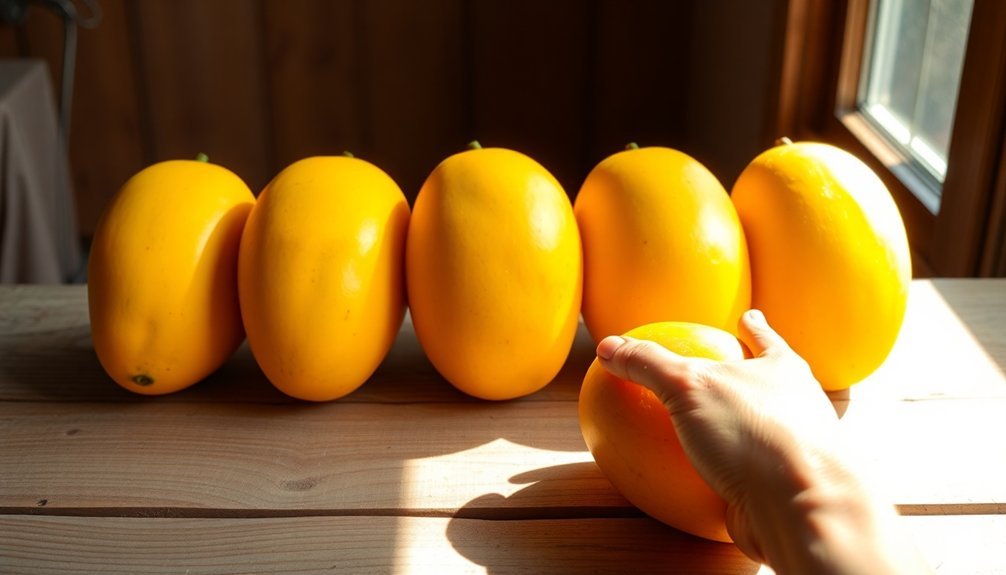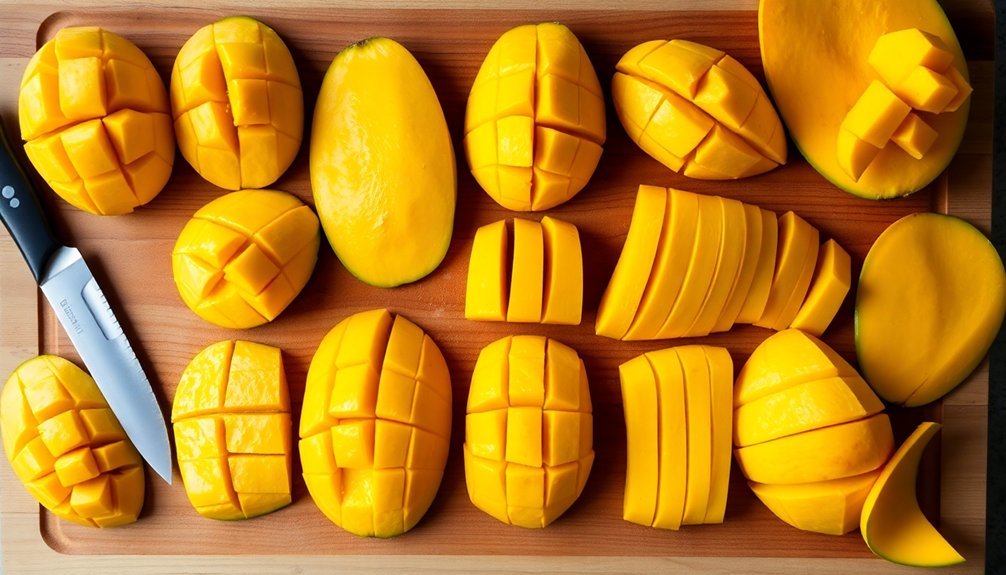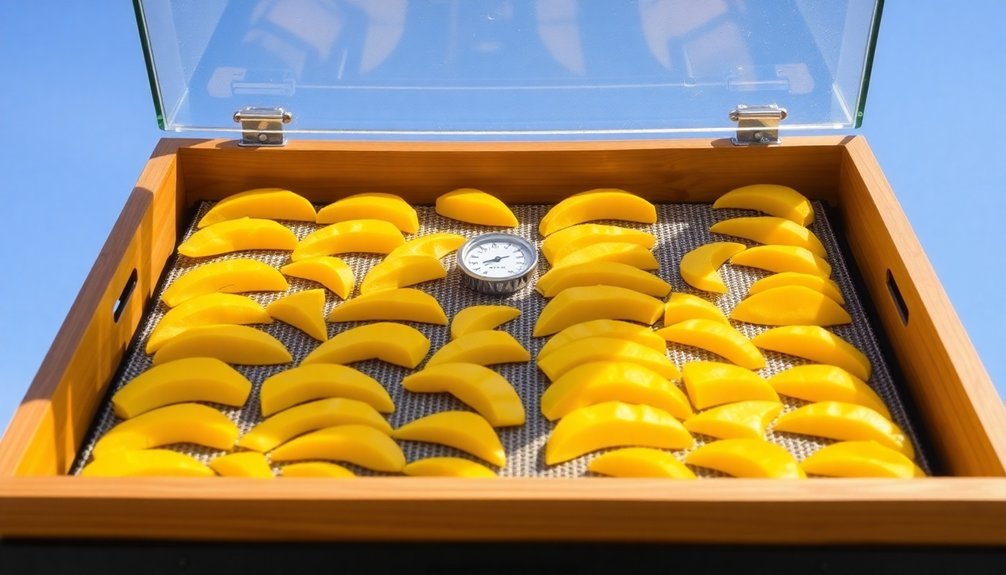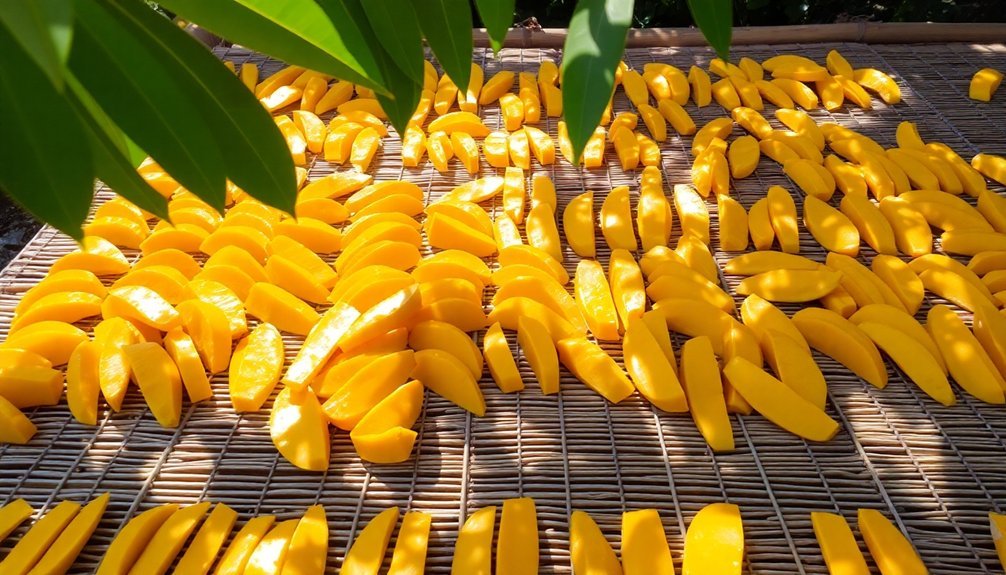To sun-dry mangoes, you'll need to select ripe, unblemished fruit with vibrant colors and a sweet aroma. Start by washing and sanitizing the mangoes in a chlorine solution, then peel and cut them into uniform 1cm thick slices. Pretreat the slices with citric acid or lemon juice to prevent browning, and optionally add sugar for enhanced flavor. Place the treated slices in a single layer on clean mesh screens inside a solar dehydrator or protected sunny area. Dry for 4-5 days, flipping occasionally, until the pieces are pliable but not sticky. Following proper storage methods will help your dried mangoes last up to a year.
Selecting Perfect Mangoes

Many home food preservation enthusiasts overlook the critical first step of selecting the right mangoes for sun-drying. You'll need to carefully examine each mango through visual inspection, checking firmness, and evaluating the aroma to guarantee ideal results.
When you're selecting mangoes, look for fruits with vibrant colors typical of their variety. For Ataulfo mangoes, you'll want a bright orange hue, while green varieties like Kent or Tommy Atkins might show subtle yellow or pink spots when ripe. Consider placing mangoes in a paper bag overnight to speed up ripening if needed. Avoid any mangoes with black spots, as these indicate rot that'll ruin your drying process.
Test the firmness by gently squeezing the mango – it should feel similar to a ripe avocado, with some give but not mushy. You don't want overripe mangoes that are too soft or show excessive wrinkles.
Next, smell the stem area; you're looking for a sweet, fruity aroma similar to ripe pineapples. If there's no smell or an unpleasant odor, move on to another fruit.
Remember that different varieties display unique ripeness indicators, so you'll need to adjust your selection criteria based on the specific type you're choosing.
Cleaning and Sanitizing
Prior to sun-drying your mangoes, you'll need to thoroughly clean and sanitize them to confirm food safety. Start by carefully sorting the mangoes, removing any damaged or spoiled ones to prevent contamination. Place mangoes in a well-ventilated area during the cleaning process. Rinse them under running potable water and gently scrub with a vegetable brush to remove dirt, debris, and pesticide residues.
Next, prepare a disinfectant solution following proper concentration guidelines (100 ppm chlorine). Soak your mangoes in this solution, making sure the pH is below 7.5 for effective sanitization. If you're processing fresh-cut mangoes, use a combination of mild detergent and hot water. For commercial processing, you can use a mango cleaning machine.
After soaking, thoroughly rinse the mangoes with clean water to remove all disinfectant residue. You can use multiple rinse steps with antimicrobial chemicals like peroxyacetic acid or acidified sodium chlorite. Maintain the rinse water's pH between 6.5-7.0 when using chlorine-based sanitizers.
Finally, dry the mangoes completely using clean cloth or paper towels. Confirm all your processing surfaces and utensils are sanitized between batches to maintain proper hygiene throughout the process.
Peeling and Cutting

With clean and sanitized mangoes ready, the peeling and cutting process begins. You'll need to remove the skin of the mangoes using a sharp knife, making certain to eliminate any damaged or discolored sections as you go. It's important to complete the peeling before moving on to cutting to prevent contamination. If you're planning to make fruit leather, start peeling from the corners to make the process easier later on.
Once you've peeled the mangoes, it's time to cut them into appropriate pieces. You'll want to slice the mango flesh lengthwise to create uniform pieces that will dry evenly. Aim for slices that are approximately 1 cm thick, as this thickness promotes consistent drying throughout. This method helps prevent waste since you can use bruised or overripe fruit for dehydrating.
Work your way around the seed, maintaining uniformity in your slices as much as possible. For those making fruit leather, you'll need to take an extra step by blending the sliced mangoes into a smooth pulp.
Remember that uniform cutting is vital for even drying, so take your time to confirm each slice is consistent in thickness and size.
Pretreatment Solutions
You'll find several effective pretreatment solutions for your mango-drying process, including citric acid mixtures and natural lemon juice alternatives.
For the citric acid method, you can prepare a simple solution using food-grade citric acid and water, while the natural lemon juice approach requires 8-9 tablespoons of fresh juice per 10 liters of water.
If you're looking to enhance both preservation and flavor, you can opt for a combined sugar-salt dip using a 20% solution concentration before sun-drying your mangoes.
Citric Acid Solution Basics
One essential step before sun-drying mangoes involves preparing a citric acid solution as a pretreatment. You'll need to mix 1 teaspoon of citric acid with 1 liter of water, or alternatively, use a 1:1 ratio of 1% citric acid and 1% ascorbic acid for enhanced preservation. Make sure you've thoroughly mixed the solution before use.
Once your solution is ready, you'll need to submerge your freshly cut mango slices completely in the mixture. You can soak them for as little as 2 minutes or up to 18 hours, depending on your desired results. This treatment prevents oxidation and browning while protecting the mangoes' nutritional value, especially vitamin C content.
The citric acid solution notably improves the quality of your dried mangoes. It helps maintain their vibrant color, enhances their rehydration properties, and can extend their shelf life for up to a year. You can combine this pretreatment with other preservation methods, like adding sugar or SO2, for better results.
Remember to maintain proper hygiene throughout the process to avoid contamination. After treatment, arrange the mango slices in single layers, ensuring they're ready for the drying process.
Natural Lemon Juice Method
The natural lemon juice method offers a simple and accessible alternative to citric acid pretreatment for sun-dried mangoes. You'll need to create a solution by combining lemon juice with water in the correct proportions. For ideal results, mix 1 cup of lemon juice with 4 cups of water, or if you're working with larger quantities, use 8-9 tablespoons of lemon juice per 10 liters of water.
| Solution Ratio | For Small Batches | For Large Batches |
|---|---|---|
| Lemon Juice | 1 cup | 8-9 tablespoons |
| Water | 4 cups | 10 liters |
| Soaking Time | 2-3 minutes | 2-3 minutes |
Once you've prepared your solution, submerge your freshly sliced mango pieces completely in the mixture. Let them soak for a couple of minutes to allow the acid to penetrate the fruit. The citric acid naturally present in lemon juice works effectively to prevent browning and helps maintain the mango's appealing color throughout the drying process. You'll notice that this treatment also helps preserve the fruit's natural vibrancy and freshness. After soaking, remove the slices and proceed with the drying process as usual.
Sugar-Salt Dipping Options
Preparing mango slices with sugar or salt pre-treatments offers distinct advantages for sun-drying, though each method affects the final product differently.
When using sugar pre-treatment, you'll need to combine it with ascorbic and citric acid solutions for the best results, as sugar alone doesn't greatly protect nutrients or enhance the drying process.
For salt pre-treatment, you'll soak the mango pieces in a salt solution for three days, which helps draw out moisture and guarantees uniform drying. The salt solution can be reused for seasoning additional batches of mangoes.
- Sugar pre-treatment works best when:
- Combined with acid solutions
- Used before microwave or oven drying
- Focusing on improving taste and texture
- Aiming for better rehydration properties
- Salt pre-treatment is ideal when:
- Using traditional sun-drying methods
- Looking for even moisture distribution
- Seeking longer preservation periods
- Planning to process multiple batches
While sugar pre-treatment may result in higher loss of β-carotene and vitamin C, it enhances sensory characteristics like taste and texture.
Salt pre-treatment, on the other hand, focuses more on the drying process and flavor preservation rather than nutrient retention.
Solar Dehydrator Setup

Building a solar dehydrator requires careful attention to design elements and proper assembly techniques. You'll need to construct a wooden frame using 2x4s, creating a box-like structure that's sturdy enough to support all components.
Install a glass or glazing panel on top to capture solar heat, and apply black paint to enhance heat absorption.
Inside the dehydrator, mount aluminum-framed fiberglass screens to hold your mango slices. Add a piano-hinged door for easy access when loading and unloading fruit. Line the interior with wide foil to optimize heat distribution throughout the chamber.
You'll need to drill strategic holes for proper air circulation – place intake holes near the base and exit vents at the higher end.
Position your dehydrator in full sunlight, making sure the glazing faces the sun directly. You can add a recycled computer fan for enhanced air circulation or rely on natural convection.
If temperatures climb too high, use a simple shading mechanism to regulate heat. Don't forget to cover the unit with mosquito netting to keep insects away from your drying mangoes.
Confirm the dehydrator sits level and stable to prevent any disruption to the drying process.
The Drying Process
Once you've properly prepared your mango slices, success hinges on following precise drying procedures.
Position your plastic mesh in a well-ventilated area with direct sunlight, guaranteeing you've laid out the treated mango slices in a single layer with adequate spacing between pieces. You'll need to protect your drying area from birds and flies by using appropriate enclosures while maintaining proper airflow.
The complete drying process typically takes 4-5 days, during which you'll need to monitor both the mangoes and weather conditions carefully. You should flip the slices periodically to achieve uniform drying and avoid any areas of moisture retention.
Here are the critical monitoring points during the drying process:
- Check weather forecasts daily to guarantee ideal drying conditions
- Maintain cleanliness of the drying area to prevent contamination
- Monitor the mangoes' moisture levels throughout the process
- Adjust exposure to direct sunlight if needed to prevent over-drying
When your mango slices have reached the proper dryness, you'll need to package them immediately in airtight containers.
Store these containers in a cool, dry place to maintain quality and extend shelf life.
Testing for Readiness

After several days of drying, you'll need to master the art of determining when your mango slices have reached ideal dryness. You'll want to test the slices by gently bending them – they should be pliable but not sticky to the touch. The texture you're aiming for is slightly flexible while maintaining the proper moisture content for long-term storage.
When examining your dried mangoes, pay close attention to their color and overall consistency. They shouldn't show any signs of fungal growth, which can appear as spots or discoloration. If you're planning to store your dried mangoes, it's vital to guarantee they're dried thoroughly enough to last up to a year without deteriorating.
Don't rush the testing process, as proper drying is essential for preservation. If you're unsure, it's better to continue drying than to package mangoes that aren't ready.
You'll know your mangoes are perfectly dried when they maintain their shape but bend without breaking, and when they're free from any sticky residue. Remember to check multiple pieces from different areas of your drying surface, as some sections may dry faster than others.
Storage Methods
Proper storage methods will lock in the quality of your sun-dried mangoes for months to come.
You'll need to choose between room temperature, refrigeration, or freezing storage options, depending on how long you want to preserve your dried fruit.
For room temperature storage, place your dried mangoes in airtight glass jars or heavy-duty plastic bags, removing as much air as possible to prevent oxidation.
Store these containers in a cool, dark place away from direct sunlight and heat sources.
If you're storing in a humid environment, add desiccant packets to absorb excess moisture.
- Room temperature storage (3-6 months): Use airtight containers, store in a cool, dry, dark place, and consider adding oxygen absorbers for better preservation
- Refrigerator storage (6-12 months): Keep in sealed containers away from strong-smelling foods, maintaining consistent temperature
- Freezer storage (up to 18 months): Use vacuum-sealed bags or airtight containers, store at 0°F or below
- General practices: Label containers with storage dates, check periodically for moisture or mold, and avoid storing near heat sources or humid areas
Remember to inspect your stored mangoes regularly for any signs of moisture or mold development, regardless of your chosen storage method.
Frequently Asked Questions
How Long Can Sun-Dried Mangoes Last if Stored Properly?
Your properly stored sun-dried mangoes can last up to 12 months at room temperature. You'll get even longer shelf life if you store them in the fridge or freezer using airtight containers.
Can You Sun-Dry Mangoes During Rainy or Humid Seasons?
You shouldn't sun-dry mangoes during rainy or humid seasons as it'll lead to mold and spoilage. Instead, use a food dehydrator or solar dryer to achieve proper drying in unfavorable weather conditions.
What Are Signs That Sun-Dried Mangoes Have Gone Bad?
You'll know your sun-dried mangoes have gone bad if you spot mold, discoloration, or a slimy texture. Watch for sour smells, unusual tastes, and any signs of pest infestation. Don't eat them if suspicious.
Can Frozen Mangoes Be Used for Sun-Drying?
You shouldn't use frozen mangoes for sun-drying. They'll become mushy when thawed and won't achieve the right texture. The freezing process alters their cellular structure, making them unsuitable for proper sun-drying results.
Does Sun-Drying Affect the Nutritional Value of Mangoes?
You'll find that sun-drying actually enhances mango nutrition. It retains more vitamin C than oven-drying, preserves essential minerals, and maintains protein content. The process even concentrates certain nutrients in the fruit.
In Summary
You've now learned all the essential steps to create delicious sun-dried mangoes at home. With proper selection of ripe mangoes, careful preparation, effective pretreatment, and patient drying, you'll have chewy, sweet treats that can last for months. Remember to store your dried mangoes in airtight containers and keep them in a cool, dark place. You're ready to start preserving this tropical fruit like a pro.





Leave a Reply